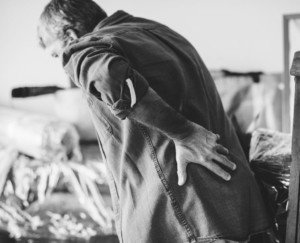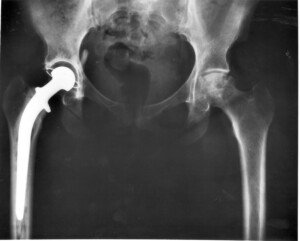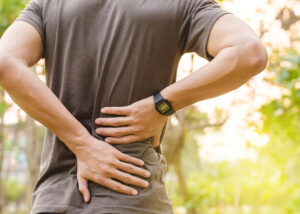
It’s not always normal to still have hip pain three months after a hip replacement. There are loads of possible causes for this pain.
The first possibility: Total hip replacement patients who fail to adhere to their rehab exercises.
If you’re too sedentary in the weeks following hip replacement surgery, there may be pain located about the hip simply due to stiff structures.
Postsurgical depression can sink in and result in being very inactive and spending a lot of time in bed — leading to a stiffened joint and underused soft tissue.
Patients also must ask themselves if the pain they’re feeling is actually coming from the hip or some other nearby area such as the thigh.
Thigh pain may radiate up towards the hip, creating the illusion that the pain is originating from the hip.
“First let me say that there is NEVER a 100% guarantee of 100% pain relief after a hip replacement,” begins Barbara Bergin, MD, board certified orthopedic surgeon at and co-founder of Texas Orthopedics, Sports & Rehabilitation Associates.
“This is a manmade operation, meant to relieve the pain of hip arthritis. Period.
“It is not meant to allow a person to return to sports or some level of activity they had when they were younger.

“Basing everything else I say on that premise, hip pain at three months might be completely normal.
“With a few exceptions, it takes the body about 6-9 months to completely recover from most injuries and surgery.
“So, pain at three months is kind of expected, and when patients tell me they have NO PAIN three months after a big operation, I thank the cosmos for sending me a happy, tolerant patient with a high threshold for pain, and reasonable expectations.
“Okay, so now that we have both extremes covered, let me think of what dangerous things might be causing pain at three months.
“Let’s start with bad things, which are not the most common things. Complications from total hip replacements are rare.
Blood Clot
“A blood clot (deep venous thrombophlebitis) could cause pain in the thigh or leg three months after a hip replacement.

Blood clot
“It’s unlikely but not unheard of, and in fact, we often keep patients on baby aspirin for three months after surgery on the lower extremity.
“But by then, patients are usually getting around, which means they’re pumping that venous blood out of their legs, so it’s not sitting around forming clots.”
Infection
“Infection can occur at any time following a joint replacement, from the day after, to years later.
“Patients and doctors are always on the prowl when it comes to sudden changes in pain, especially if accompanied by fever, redness or swelling.
“The surgeon takes extreme precautions and steps to prevent this disastrous outcome, and fortunately…it is rare.”
Dislocation
“Dislocations can also occur at almost any time following a hip replacement, but are less likely to occur as time goes by.
“There will be no question in the patient’s mind that something very bad has occurred, when the hip dislocates.
“Not only is it painful, but they will not be able to move. It can occur as the result of a fall, but it can also occur with some very common movements.
“This will require a visit to the emergency room because of the pain.
“The hip will be put back in place. Surgeons also take many steps to prevent this kind of problem, and it too is rare.
“Now to the less dangerous, although always concerning causes of pain.”
Activity
“Soreness from increased activities occurs as patients get more active, once the surgical pain has died down.
“They’ve returned to the gym, started walking more or might have increasing demands placed on them in physical therapy.”
Seroma
“Minor surgical setbacks can occur in this period of time, like the development of seromas (fluid leaking out of the depths of the wound, and causing swelling and pain).”
Small Fracture
“Occasionally a small fracture could result from the surgery. The surgeon usually knows when this occurs and depending on what type of fracture, they might fix it at the time of the surgery.
“There might be some remote possibility that a tiny fracture could be missed, and this could result in pain later on if it doesn’t heal. Again…rare.”
Loosened Hardware
“There is an unlikely chance that something could come loose after the surgery. Again, very rare, but there would be some pain associated with it.”
Activities that Can Loosen Hip Replacements (especially cement) and Cause Pain
- Impact (jogging, tennis, horseback)
- Heavy weightlifting
- Jumping from heights
- Gaining excess weight
Not following the rules for the first eight weeks following hip replacement surgery could result in pain that lingers.
Don’t bend the operated hip beyond 80 degrees.
Don’t raise your knee higher than hip.
Avoid sitting on low seats.
Avoid leaning forward when sitting.
In rare cases hip pain can result from leg length disparity or nerve damage.
If you’re still having pain three months out, or you have new-onset pain three months or so out from the hip replacement, don’t put off making an appointment with your surgeon.
It’s rare that a pain after surgery would not have an explanation.
Additional Causes of Hip Pain that Can Persist or Develop Three Months After Surgery
(Source: Clinical Cases in Mineral and Bone Metabolism, Ferrata et al, 2011)
• Bone loss
• Abnormal formation of bone
• Bone remodeling in response to physical stress
• Inflammation of synovial fluid
• Allergy to metal wear debris
• Prosthesis impingement
• Iliopsoas tendinitis
• Abductor muscle damage










































